Barnegat Inlet
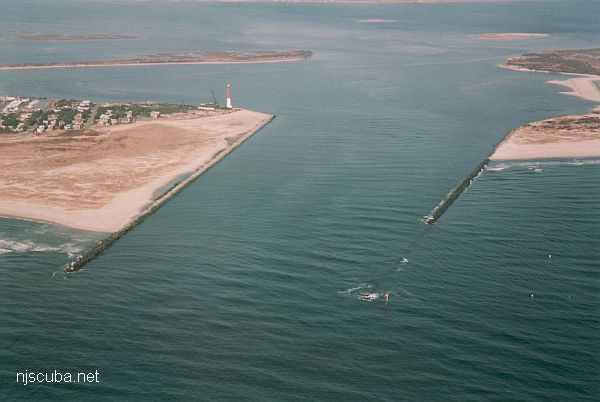
- Type:
- major ocean inlet with strong current, surf, and heavy boat traffic
- Depth:
- 45 ft
The outside of the north jetty is diveable, however, getting to this dive site may not be easy. The road on the north side ends a quarter-mile short of the inlet, so either a four-wheel drive and a beach permit, or better yet a boat, would be needed. Spearfishing the outside of the north jetty is reported to be excellent.
I dove the inside of the inlet once, under special circumstances, along the bulkhead in the park near the lighthouse. The water was clean and clear, and the bottom was white sand over clay.
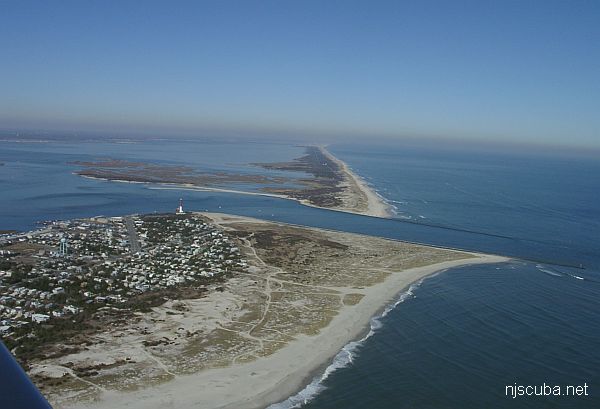
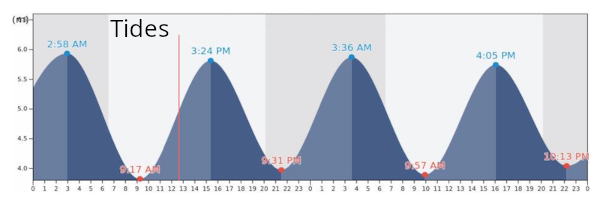
Jack Fullmer fought for years to get the jetties open to divers after they dredged the inlet channel, and was finally successful. As of Fall 2008, here are the new regulations for diving Barnegat inlet:
N.J.A.C. 13:82-3.17 (2006)
13:82-3.17 Diving and swimming
(c) Provisions for Barnegat Inlet are as follows:
- Except as provided in this subsection, no person or persons shall, while engaged in goggle-fishing, spear fishing or skin diving, enter into any navigable channel or approach within 200 ft of any boat anchored or underway within the water adjacent to the land areas of the Borough of Barnegat Light.
- No person shall dive in any of the waters of the Barnegat Inlet channel.
- Skin and Scuba diving is permitted from the north and south jetties, but no person shall dive further than 25 ft from the rock jetty or bulkhead within the inlet.
- No person shall dive within Barnegat Inlet between 8:00 A.M. and 5:00 P.M. on Saturdays and Sundays from June 1 to September 30.
- A diver shall mark his or her position with a float and skin diver's flag.
- Only "buddy diving" will be permitted in Barnegat Inlet.
- Recreational diving is prohibited within 100 ft of the north monument.
- Recreational diving is prohibited within the inlet when the current is at flood.
Barnegat Lighthouse:
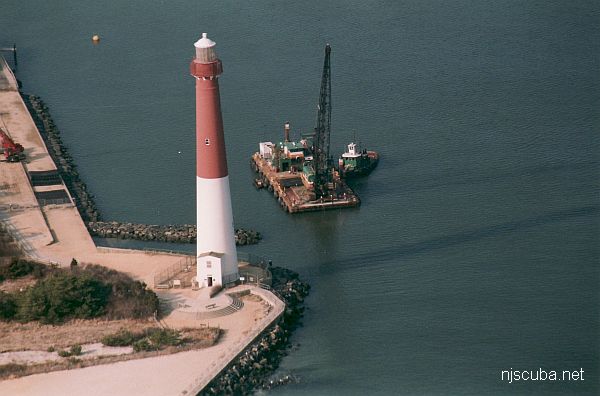
February 2001: Repairs underway to save the lighthouse from erosion.
The first lighthouse here was built in 1824. The current tower dates to 1859, and is no longer in use as a navigational aid, but has become a beloved symbol of the Jersey shore. The name Barnegat is derived from the original Dutch Barende Gat, given by Henry Hudson in 1609. Gat is Dutch for a narrow inlet or passage; Barende is Dutch for breakers ( as in waves. )
The lighthouse was originally built 900 ft from the inlet, which has moved steadily southward since then. Concrete bulkheads and stone jetties now protect the tower, which was also moved onto a new stronger foundation a few years ago ( you can see the old foundation in front of the tower in the picture above). It was thought to be safe until currents scoured out a deep hole in the channel next to it, which the derrick barge in the picture is engaged in filling in with rock.
Ocean inlets like this are not naturally stable but move around, close up, and reopen, as the ocean, rivers, and storms rearrange the sands. In the past 300 years, there have been inlets at Sea Bright, Sea Girt, Bay Head, and Toms River, all of which have closed up. Modern-day inlets are maintained in place by stone walls and constant dredging.
Experts Seek Origins of Old Mystery Shipwreck in Inlet
Dan Radel, December 12, 2015
ASBURY PARK PRESS

Contractors uncover a century-old shipwreck during superstorm Sandy repairs to Barnegat Inlet
ISLAND BEACH STATE PARK - Last summer, workers doing repairs to Barnegat Inlet unearthed more than just sand - they found pieces of timber that turned out to be remnants of a century-old shipwreck. The identity of the doomed ship is still unknown, but the hunt for answers has brought in maritime forensic experts all looking for clues to the boat that lay under the jetty, undiscovered for decades.
"It's another amazing find. I had no knowledge of it. It's not a vessel that divers could have got to - it was under the jetty, and it was really before the time of scuba divers," said Dan Lieb, trustee at the New Jersey Shipwreck Museum in the InfoAge Science Center in Wall.
New Jersey's reputation of being a hazardous coast to mariners earned it the nickname "Graveyard of the Atlantic." While the numbers vary, most agree that somewhere between 4,000 and 7,200 shipwrecks have occurred on the New Jersey coast, Lieb said.

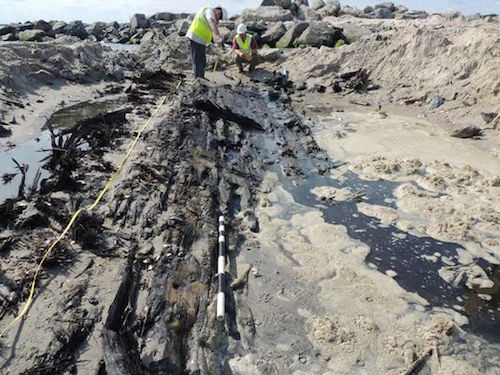
The wreck was found at the tip of the Barnegat Inlet North Jetty, at the southern end of Island Beach State Park during a $7 million-plus superstorm Sandy repair project. It was the second buried shipwreck found during Sandy repair projects. Workers building a sea wall in Brick last November struck timber on what was believed to be a mid-18th century wreck.
There was speculation that the Brick wreck might be an old barge or possibly the Ayrshire, a Scottish brig that grounded on to a sandbar on Jan. 12, 1850. But the identity is still a mystery.
The shipwreck discovered at Barnegat Inlet is also thought to be a barge, which makes it hard to identify because they were ubiquitous workhorses for the time and many didn't even have names, according to Panamerican Consultants Inc. of Memphis, Tennessee, one of the subcontractors brought in to find out the ship's identity.
The Barnegat Inlet North Jetty was constructed between 1938 and 1941 and the U.S. Army Corps of Engineers suspects workers then built on top of it, unaware what lay hidden beneath the sand.
Repair work was moved to another part of the inlet while excavations took place, said Tim Boyle, a spokesperson for the Army corps' Philadelphia District. Archaeologists pulled components including stern deadwood, a rudder, and a windlass from the wreckage. The recovered material came from only one side of the hull from about the deck down to the bilge.

The components indicate the vessel was built between 1876 and 1914. "Once we realized what we found wasn't pieces of debris from the project we brought in a cultural expert," Boyle said.
Nicole Cooper Minnichbach, a cultural resources specialist for the Army corps, sifted through sections of hand-hewn, wooden hull fragments, treenails, and various metal fasteners. After she determined they were parts of a shipwreck, the full body of which was still buried in the sand, the hunt began for its name and information on how it sunk.
"The remaining buried amount of hull is conjecture, but it is likely that at least half the hull to the keel is intact, and even the entire port side of the vessel could be present as well," an Army corps report on the discovery said. The vessel was most probably near 200 feet in length. A full excavation did not occur, and the remaining hull covers an area of at least 55 feet in length. The removed components did not contain any evidence of the bow, which suggests a great deal more is still in the sand.
Panamerican dove into historic records, including shipwreck databases from the National Oceanic and Atmospheric Administration and the New Jersey Maritime Museum, and culled through the response records of the Life-Saving Service, newspapers, and interviews with locals. They cross-referenced the data with field observations and wood analysis to conclude the vessel was most likely a schooner barge built in the Northeast.
An early candidate for the vessel was the Dixie. Of all the surrounding shipwrecks, this was the largest vessel to have come ashore at what was then called North Beach and was responded to by both nearby lifesaving service stations. It was lost on April 20, 1893.
The Dixie had a length of 160 feet. It was built as a schooner barge in 1890 at Portsmouth, Virginia, by D.B. Isham & Son and was owned by Frank N. Isham. However, it was constructed from oak and pine and had iron fastenings - at odds with the analysis of wood recovered from the wreck site, which was larch, tamarack, and birch, all northern species of wood.
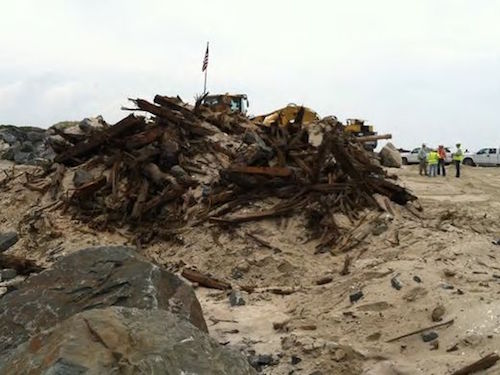
Panamerican has narrowed the wreck down to three unnamed schooner barges, known as No. 20, No. 21, and No. 28, all of which sank off Barnegat on Feb. 4, 1926, carrying cargoes of coal heading to Boston from Norfolk. No. 20 and No. 28 had been built in 1899 at Bath, Maine, and No. 21 was built in Baltimore in 1901. The construction time period, identified wood types, and vessel length are all in line with what has been determined from the Barnegat Inlet wreck.
But even with all the maritime forensic work, the truth is the ship's identity may never be known. "About half the wrecks that have left a permanent mark on the bottom, a keel or something, are unidentified," said Lieb.
John DeWolf II
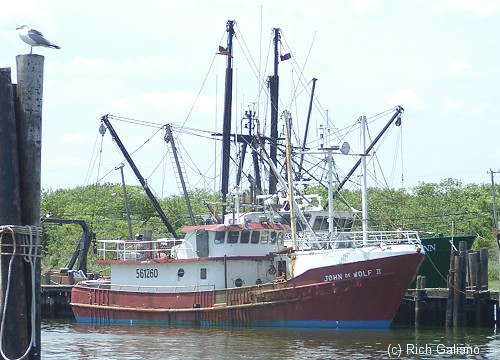
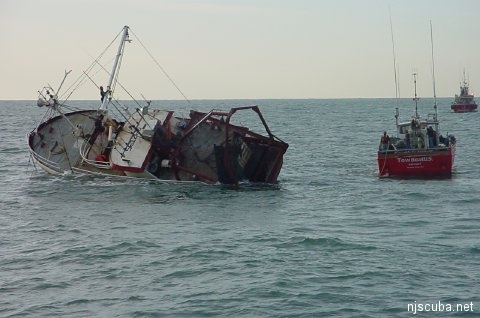

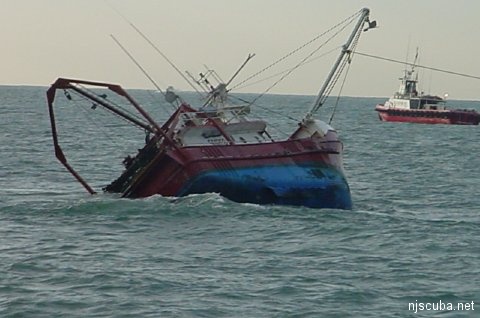
The John De Wolf II, a scalloper out of Barnegat, fouled her prop on a buoy line and capsized just outside the inlet. No one was hurt as far as I know.
Fishing boat sinks near Barnegat Inlet
After hitting a buoy, the 54-foot boat drifted onto a beach, refloated, then sank as it was towed.
A 54-foot fishing boat that drifted ashore just south of the Barnegat Inlet on Tuesday was refloated yesterday only to sink as it was being towed into port, authorities said. The steel-hulled John De Wolf II struck a buoy in the inlet Tuesday as it was heading out to sea on an ebb tide. A chain from the buoy became tangled in the vessel's propeller, and the engine ground to a halt, said Kimberly Smith, a spokeswoman for the U.S. Coast Guard.
Before a rescue crew could arrive, the boat floated out of the inlet and became stranded on a beach. The two people and a dog on board waded to shore without injury, Smith said. About 8:30 p.m., after the boat's diesel fuel and oily bilge water were removed, Shamrock Towing unsuccessfully tried to tow the vessel with the high tide, Smith said. The boat was brought afloat yesterday, but about noontime, it sank while being towed 1 1/2 miles south of the inlet. Now considered a wreck, the John De Wolf II rests under 22 feet of water awaiting a salvage operation. The Coast Guard's Marine Safety Unit/Philadelphia is investigating the incident.
Contact staff writer Sam Wood at 856-779-3838 or at samwood@phillynews.com.
Scallop boat hits buoy, runs aground
Published in the Asbury Park Press 10/27/04
By GREGORY J. VOLPE and NICHOLAS CLUNN
STAFF WRITERS
BARNEGAT LIGHT - A 70-foot scallop boat washed ashore after striking a buoy yesterday morning and remained stuck in the sand off 10th Avenue for most of the day. The John deWolf II was heading to sea to harvest scallops sometime after midnight when it struck a buoy in Barnegat Inlet, damaging the boat's propeller, which caused the engine to break, said Keith Larson, who maintains the vessel, which belongs to his father, John.
The crew dropped anchor, but the line broke, and the boat drifted to shore. The captain, Louis Roberson, another man, and a dog, were safely ashore by 5:30 a.m., officials said. "That's the main thing, " said Jim Gutowski, a scallop boat owner and assistant dock manager at Viking Village. "No injury. No environmental situation." Gutowski said he thinks the captain misjudged the depth of the water because of quick-moving tides. "There's been a lot of easterly wind, a big swell in the inlet, and the tides are abnormally high, " he said. "Sometimes it can trick you, and it looks like it's coming in, but it's going out fast."
The boat stood on the beach, leaning slightly toward the water as crews worked to get it back to sea, and people gathered to watch. "You never know what you're going to find on the beach on Barnegat Light, " said Carol DeMerritt, who owns a summer home in town. "All kinds of treasures wash up." She saw the boat while walking and rushed home to tell her husband. "Holy cow, " said Steve DeMerritt, 67. "This is pretty amazing."
Under the oversight of the Coast Guard and state Department of Environmental Protection, workers were pumping gas and potable water off the boat while a backhoe dug a trench around it in hopes of being able to float it away, said Rob Schrader, DEP emergency response specialist. Schrader said there were no environmental problems and the sand dug out would return naturally in about two days. Towboats were planning to tug the boat away at high tide, around 7 p.m. yesterday. Gutowski said it would be difficult to get the boat off the beach and over a sand bar to deep water. "They have to get him enough oomph to bounce him over that bar, " he said.
Though the boat just touched the water's edge yesterday afternoon, Bob Van Meter, captain of the Barnegat Light First Aid Squad, said waves were hitting its side, sending water over its deck. Van Meter said he's seen about 20 boats wash ashore in his 40 years on the first aid squad; several have been commercial.
Joe Procida, 86, of Woodlynne, Camden County, has fished on the island for 30 years and never saw a sight like he saw yesterday. "It's something for me to see; I wish them luck in getting out, " he said. "I was wondering if it was going to be another one.' He was referring to the Sea King, a wreck that washed ashore about 40 years ago in a similar location. A raging sea combined with the weight of a boat in tow pushed the Sea King into treacherous shoals that have helped make Barnegat Inlet one of the most dangerous inlets on the East Coast. Its wooden mast still juts out from the beach a few hundred feet inland from where the John deWolf II was lodged yesterday.
Press Release Date: October 27, 2004
Contact: PA1 Kimberly Smith
609-517-1268
FISHING VESSEL SUNK NEAR MOUTH OF BARNEGAT INLET
ATLANTIC CITY, N.J. - the Coast Guard Marine Safety Office (MSO) in Philadelphia, Pa., is overseeing cleanup and salvage operations for a fishing vessel that sunk a mile and a half south of Barnegat Inlet. Coast Guard Group Atlantic City received a report from the fishing vessel John De Wolf II that they were disabled after hitting a buoy while transiting out of the Barnegat Inlet.
A 47-foot rescue boat from Coast Guard Station Barnegat Inlet headed to the scene, but before the crew could arrive, the vessel floated out of the inlet with the ebbing tide to become stranded on the beach south of the inlet. The two people and a dog on board the fishing vessel waded to the beach where crewmembers from Station Barnegat Light waited to give them assistance. No injuries were reported.
The owner of the 54-foot Barnegat Light fishing boat contracted Northstar Marine to remove the diesel fuel and oily bilge water from the vessel before Shamrock Towing attempted to tow the vessel off the beach. At 8:30 p.m. last night, Shamrock Towing attempted to refloat the vessel with high tide but was unsuccessful.
The vessel was successfully refloated today, but sunk at about 11:45 a.m. while being towed back to the inlet. MSO Philadelphia is currently investigating.
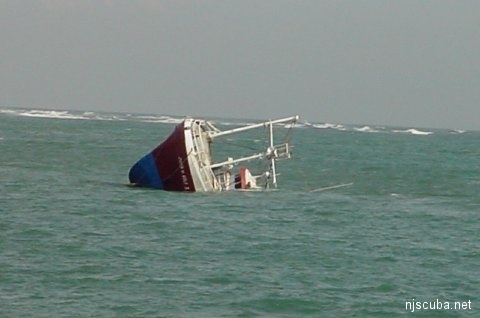
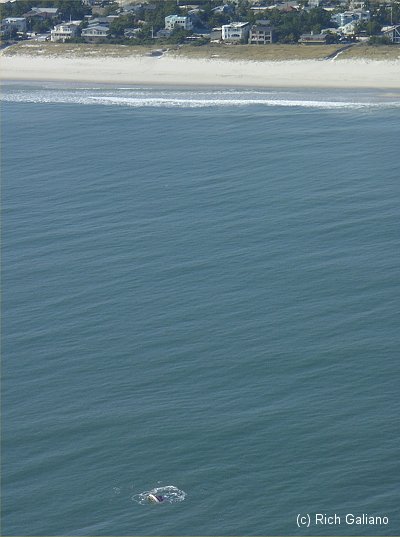

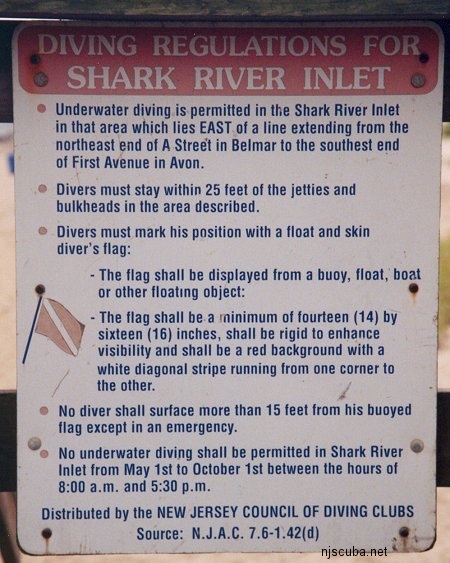
Questions or Inquiries?
Just want to say Hello? Sign the .